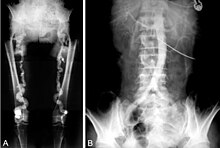Mönckeberg sclerosis
As Mönckeberg sclerosis , engl. Mönckeberg's sclerosis , Media sclerosis (from Mönckeberg) or Mediakalzinose , one calcification of the middle wall layer (referred tunica media ) of the limb arteries . In contrast to atherosclerosis , the inner lining of the vessel wall ( tunica intima ) is not affected. Both forms of vascular calcification can occur together or individually.
Medial sclerosis typically does not lead to a narrowing of the vascular lumen on its own and thus not to a vascular occlusion , but the vascular wall can harden so much that the artery is no longer correspondingly compressed when the blood pressure is indirectly measured and blood pressure that is too high is measured ( Pseudohypertension).
Men get sick more often than women (male: female = 3: 1). Diabetes mellitus , kidney failure and primary or secondary hyperparathyroidism favor the development of this vascular disease.
The name goes back to the first descriptor Johann Georg Mönckeberg (1877-1925).
Cause and origin
Possible causes are hypercalcemia and degeneration of the smooth muscles of the larger arteries. Media sclerosis is then caused by deposits of calcium salts ( apatite ) and lipids . In rare cases, osteoid or bony structures (with bone marrow ) can also form.
Clinical manifestations
Media sclerosis leads to hard walls in the arteries. It can therefore lead to incorrectly high values in indirect blood pressure measurement (pseudohypertension). The measured values can in some cases exceed 300 mmHg. It does not have any other independent clinical significance. The media sclerosis can mask peripheral arterial occlusive disease or lead to misdiagnosis.
Investigation methods
Medial sclerosis is found as a tubular calcification of arteries as a secondary finding in radiological examinations of the skeletal system. If the underlying illnesses in a patient are not yet known, such a finding can be a reason to search for them. Angiography shows open vessels in medial sclerosis without significant fluctuations in the internal diameter. Typically, the blood pressure measured by Doppler sonography on the ankles is at least 1½ times as high as on the wrist ( ankle-arm index > 1.5).
pathology
During the examination, the affected arteries may show a corrugation, which is reminiscent of the cartilage braces of the trachea (hence the term “goose gurgle arteries”, which has been handed down in medical history).
treatment
Treatment is not necessary due to the lack of clinical relevance.
literature
- JG Mönckeberg: About the pure media calcification of the extremity arteries and their behavior towards arteriosclerosis. In: Virchow's archive. Vol. 1903, pp. 141-167.
- CE Couri, GA da Silva, JA Martinez, F. de A. Pereira, FJ de Paula: Mönckeberg's sclerosis - is the artery the only target of calcification? In: BMC Cardiovasc Disord. 2005 Dec 12; 5, p. 34. PMID 16343348 , PMC 1326214 (free full text)
Individual evidence
- ↑ a b c d e f g h K. Meyne: Handbook of arterial occlusive diseases: a guide to the clinical picture of peripheral arterial occlusive disease, its detection and treatment. Schlütersche, 2003, ISBN 3-87706-694-1 , p. 23, (online)
- ↑ a b c W. Siegenthaler: Siegenthaler's differential diagnosis: internal diseases - from symptom to diagnosis. Georg Thieme Verlag, 2005, ISBN 3-13-344819-6 , pp. 325–326. (on-line)
- ^ W. Böcker et al.: Pathology. Urban & Fischer-Verlag, 2008, ISBN 978-3-437-42382-6 , p. 507. (online)
- ↑ K. Kröger et al.: Non-invasive diagnosis of angiological diseases. ABW Wissenschaftsverlag, 2007, ISBN 978-3-936072-55-6 , p. 23. (online)
